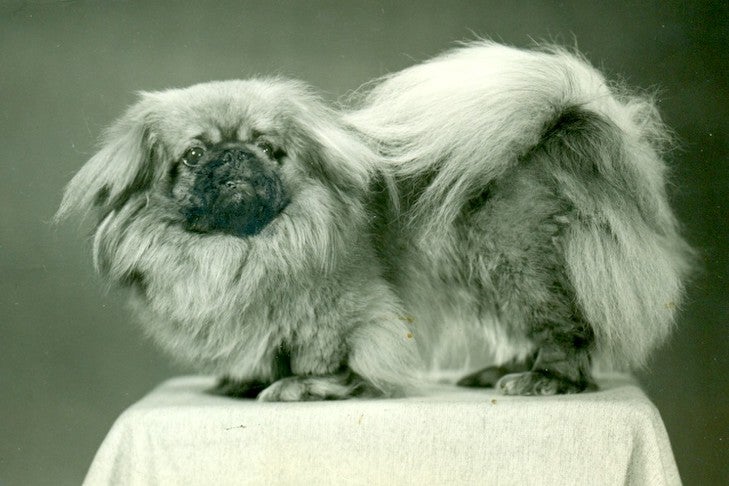
Though we often don’t think about them in this way, dogs are really about people — those long-ago (or, sometimes, not so long-ago) figures who developed particular breeds for particular tasks. Some breeds — like the Doberman Pinscher, Teddy Roosevelt Terrier, and Cesky Terrier — owe their existence to just one visionary person. Other breeds were brought into being by specific cultures or classes of people.
With coats that evolved to survive the local climate, body styles developed to navigate native terrains, and characters that fit into the social mores of the day, our purebred dogs are living, breathing moments of history, reflections of the far-flung cultures that developed and nurtured them. Through them, we rediscover our globe’s cultural diversity and heritage.
Sometimes, breeds find themselves in the center of very complex human interactions. That certainly was the case with the Pekingese, one of the world’s most ancient breeds – and one of its most mysterious until about a century ago.
In 1860, during the height of the Second Opium War, British and French soldiers scaled the 15-foot walls of Yuanmingyuan, or the “Gardens of Perfect Brightness,” in the Chinese city of Beijing, which the Europeans called Peking. They tied up their horses with yards of imperial silk, smashed priceless porcelain, and ransacked jewelry and artifacts.
When news that the negotiation for a truce had turned deadly, with some of the English-led delegation tortured and killed, thousands of British soldiers returned to destroy the 800 acres of imperial gardens and palaces. They set fire to the elaborate cedar buildings, which took two days to burn – a cultural destruction of such magnitude it has been called China’s Ground Zero.
Amid the jade carvings and bronze statues at the Old Summer Palace, as the royal compound was called, the military men stumbled across living treasures – five Pekingese that somehow hadn’t been killed to keep them out of foreign hands when the emperor and his family fled. The dogs were found in an apartment belonging to the emperor’s aunt, who had committed suicide as the military forces approached.
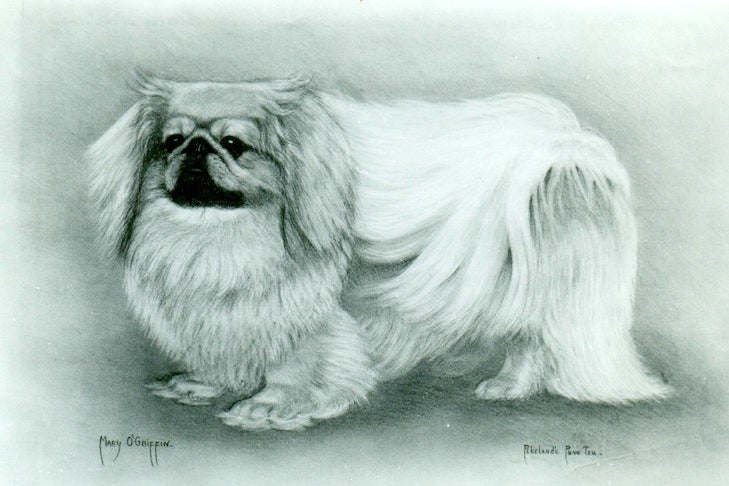
Lion + Monkey = Pekingese?
Very little was known about these pear-shaped, flat-faced toy dogs outside of their native China, where they could only be owned by the imperial family and were said to date back to the Han dynasty, more than two millennia ago.
Some historians correlate the arrival of Buddhism in China with the development of the breed. Lions are central figures in the story of the Enlightened One, and since Asiatic tigers had long been extinct in China, its devout Buddhist monks developed dog breeds – including the Lhasa Apso, Tibetan Mastiff and, yes, the Pekingese – with leonine traits, such as blunt muzzles and heavy head furnishings.
One legend held that a lion that fell in love with a marmoset monkey begged the gods to shrink him down in size so that his love could be requited. The transformation complete, his heart remained the same size.
A much later, but just as romanticized description of the Pekingese is a long-form poem breathlessly entitled “Pearls Dropped from the Lips of Her Imperial Majesty Tzu-Hsi Dowager Empress of the Flowery Land.” While the dowager empress bred Pekingese in her royal kennel (as well as Pugs and Shih Tzu), it’s not clear whether the list of desired Peke traits is authentic, or the florid prose of some later fancier. Nonetheless, it inspired the various Western standards for the breed.
“Let the Lion Dog be small; let it wear the swelling cape of dignity around its neck; let it display the billowing standard of pomp above its back,” the “dropped pearls” of wisdom begin. “… Let its eyes be large and luminous; let its ears be set like the sails of war junk; let its nose be like that of the monkey god of the Hindus. Let its forelegs be bent; so that it shall not desire to wander far, or leave the Imperial precincts. Let its body be shaped like that of a hunting lion spying for its prey.”
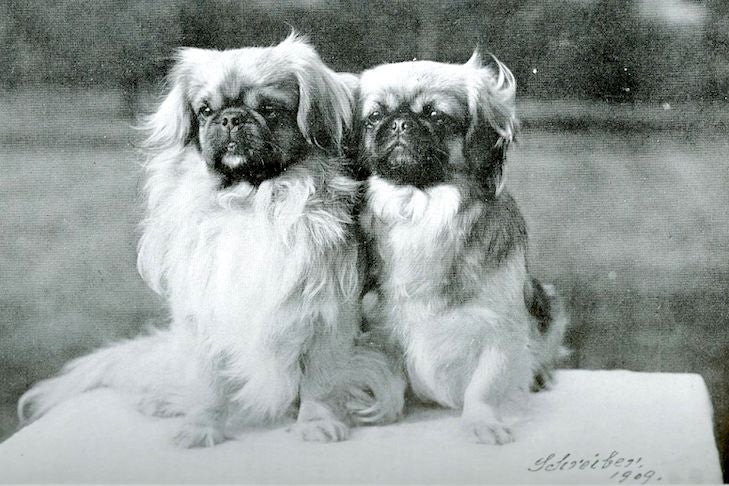
“The Most Perfect Little Beauty”
Attended to by eunuchs, living in a marble pavilion atop silk cushions, sometimes even granted an official rank at court, the Pekingese was cultivated for millennia to have an air of self-importance for which the breed is still famed.
Miniature versions were known as sleeve Pekingese, so named because they were carried in the sleeves of robes, though this tradition likely originated in early Italian courts. The dowager empress’s poem makes a connection between the Peke and court fashion: Golden sable dogs were to be carried in the sleeve of a yellow robe, for example.
Leaving the smoldering ruins of their home behind, the five purloined Pekingese from Yuanmingyuan were taken to England, where the smallest, a fawn and white female with silver bells around her neck, was presented to Queen Victoria. In what is not the most culturally sensitive pronouncement ever issued by a royal, the queen named her Looty.
“People say it is the most perfect little beauty they have ever seen,” wrote Captain John Hart Dunne, who discovered the dogs at Yuanmingyuan and let Looty make the voyage to England in his forage cap. But the queen was reportedly underwhelmed with the new addition to her royal menagerie.
Apparently, the feeling was mutual. Out of sorts with her new environs, Looty initially refused most food, which was entirely in character: The dowager empress’s “pearls” had noted the Pekingese should be “dainty in its food so that it shall be known as an Imperial dog by its fastidiousness, “ and recommended the breed be fed “sharks fins and curlew livers and the breasts of quails,” as well as “the milk of the antelopes that pasture in the Imperial parks” – items that clearly were not on the menu at Balmoral, where the queen first received Looty.
“He was a very lonely little creature, the other dogs taking exception to his Oriental habits and appearance,” recounted the New York Times in 1912, indulging in both stereotypes about Looty’s ethnicity and inaccuracy about her gender. When Looty died in 1872, she was buried in an unmarked grave at Windsor Castle.
The four remaining Pekingese were also given to British bluebloods, albeit ones who were quite a bit more enthusiastic: One pair went to the Duchess of Wellington, who named them Schlorff and Hytien, the other, to the Duchess of Richmond, Lady Algernon Gordon-Lennox, who began to breed Pekes in her famous Goodwood kennel and helped write the first standard.
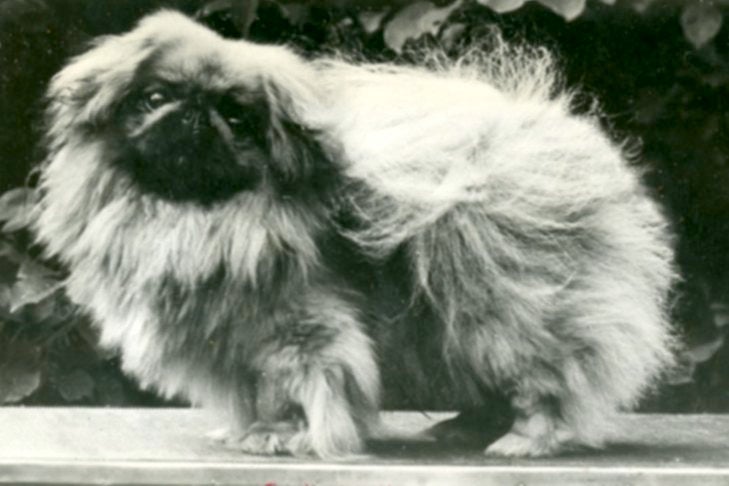
From Chinese Royals to the West
In order to establish breeding programs, more dogs were needed, but the best dogs remained closely held by Chinese royals. Still, a handful of Pekingese did come to the West, either through trickery or tribute. In the former category, servants and eunuchs at the palace reportedly spirited away some, despite the fact that the penalty for theft of the invaluable palace dogs was severe torture and, according to some sources, death. The famous Ah Cum, considered a founding sire for the breed, was smuggled to Britain in a crate of Japanese deer in 1896.
As for Pekingese being gifts, towards the end of her life, the dowager empress bestowed several dogs on well-connected Americans, including financier John Pierpont Morgan and President Theodore Roosevelt’s daughter Alice. Dr. Frederick Samuel Heuston, an Irish surgeon teaching in China, received a pair of Pekingese as a sign of royal favor after he set up vaccination clinics to successfully combat smallpox there.
A half-century after the Pekingese was brought to England as a spoil of war, the burgeoning British middle class began breeding the dogs and exhibiting them at shows, propelling them to become a popular toy breed. America fanciers were similarly enraptured. After the imperial family lost power during the Chinese Revolution in 1911, the West, ironically, became the steward of the dogs held most precious by an ancient aristocracy it had helped to topple.
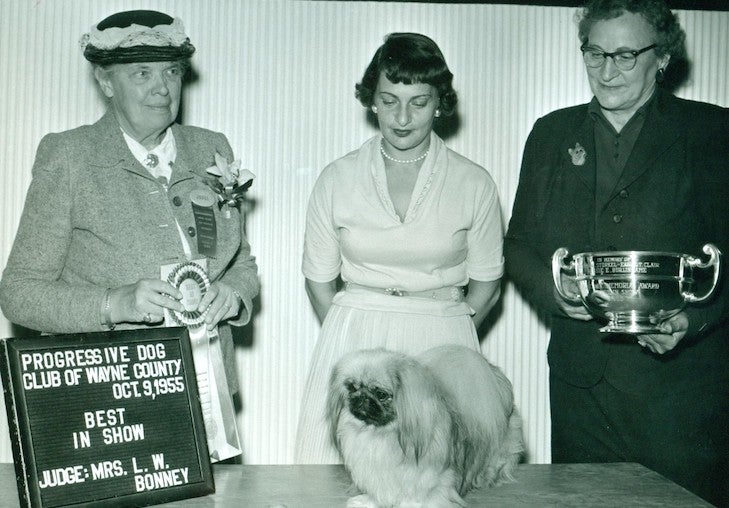
Today’s Pekingese
With their shorter legs and faces, and longer hair, today’s Pekingese are noticeably different from the dogs plundered alongside imperial scepters and elaborately carved throne chairs more than a century and a half ago.
But what the breed has retained, unquestionably, is its exquisitely honed sense of self. Regardless of what continent they reside on, or what language their owners speak, a Pekingese knows who they are – and, by extension, who you are, too. They are a creature bred for centuries to be dignified and independent, largely unconcerned with the desires of those around him them. And, in a turning of the trans-species tables, you are their servant.

